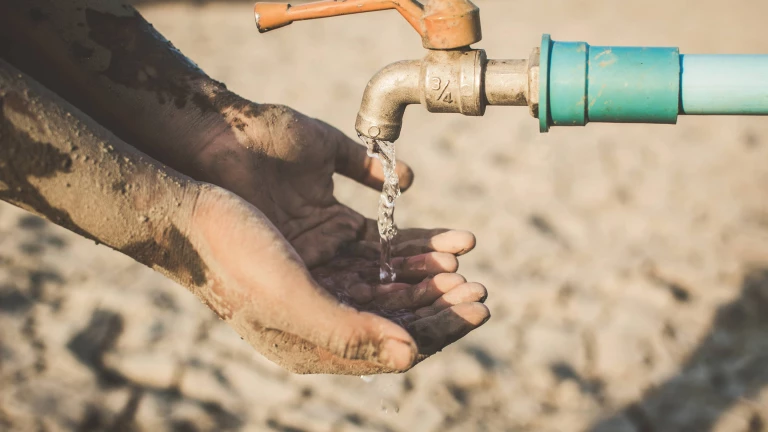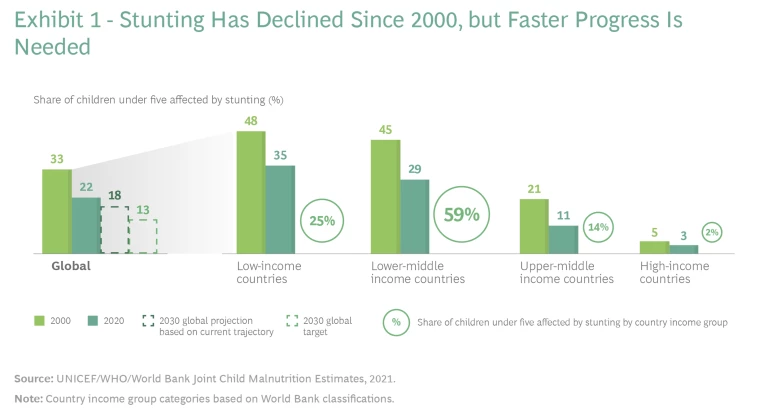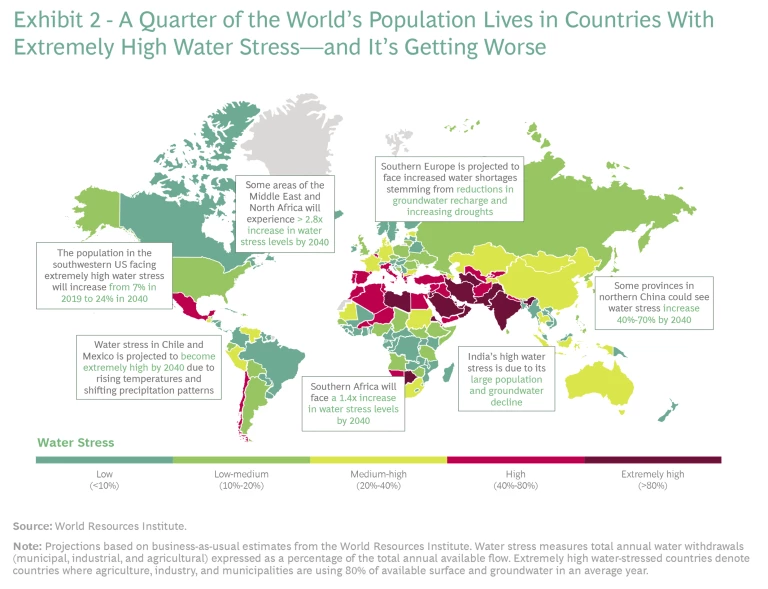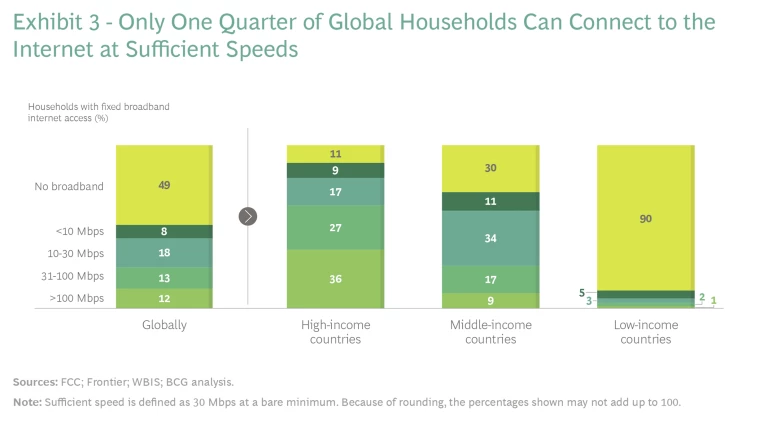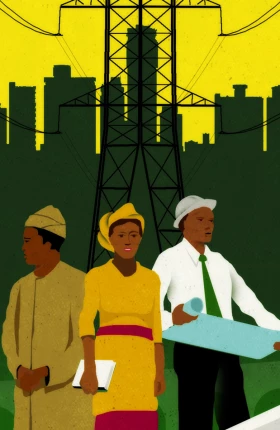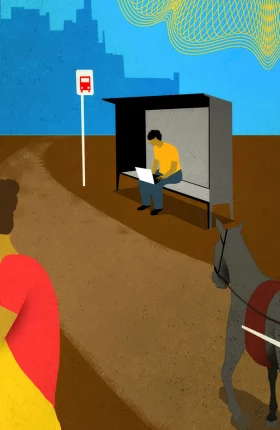When addressing critical issues such as nutrition access, clean water, and the digital divide, multilateral solutions aren’t the only answer.
This article is the third in a series providing insight on why government leaders need to look beyond economic development and prioritize the overall well-being of citizens. The first article reported the findings of BCG’s annual Sustainable Economic Development Assessment analysis, which assesses national well-being based on ten dimensions, including health, education, infrastructure, and environment. The second article explored how leaders can approach and tackle inequality. This article covers direct actions governments must take for the short- and long-term development of countries and their citizens.
Perhaps it’s human nature to try to solve complex problems in big ways—shoot for the moon, as the expression goes. But when it comes to the biggest challenges faced by governments in virtually every part of the world, complicated, multilateral solutions are not the only viable answer anymore.
While some outsized issues, such as dealing with pandemics or global environmental concerns, can only be addressed with large-scale efforts, coordinating solutions among numerous stakeholders with different agendas is often a daunting task. One only has to look at climate change to see how difficult it is to get numerous countries to all pull in the same direction consistently, especially in an era of rising polarization, nationalism, and tribalism. And when big initiatives hit roadblocks, governments tend to embrace the opposite approach—safer, short-term projects such as repairing bridges or opening a new hospital. These are important projects and can have a very positive effect on local well-being (as well as local political careers) but they are usually limited in terms of global impact.
Multilateralism is not always possible, but BCG sees another path for the public sector. We believe that rather than shying away from addressing challenging issues, governments should drive change by thinking big and acting fast—but starting small. In practice, this means viewing an issue of global concern through a local lens, addressing it with a pragmatic but innovative solution, and then—as positive results emerge in small pockets—scaling it so its reach broadens across wider regions and groups of people.
Addressing Three Big Challenges
To test out this idea, we picked three challenges that are fundamental to the short- and long-term development of countries and their citizens: the need for food, the need for clean water, and bridging the digital divide. Ensuring the mental and physical development of children through proper nutrition and clean water is an essential task for government; 12 of the 17 United Nations Sustainable Development Goals (SDGs) involve nutrition, while 7 of them involve water-related targets. Meanwhile, expanding digital access and learning can unlock human development and economic growth and create a level playing field for future generations. As UN Secretary-General António Guterres put it, narrowing the digital divide “could become the greatest equalizer in promoting equality.”
The three critical global imperatives identified by BCG can be successfully tackled through swift action, starting locally with smaller projects and initiatives before scaling up. These smart solutions eschew multilateralism for simplicity, and they deliver economic, social, and political benefits that outweigh their costs. Moreover, these “no regret” actions are directly within governments’ remits and areas of responsibility.
Imperative #1: Enhance Access to Nutrition from Ages Zero to Three, and Promote Healthy Diets for All Ages
Low and inadequate nutrition, known as hidden hunger, during the first 1,000 days of life can have significant long-term effects, including irreversible stunting of growth, cognitive ability disorders, and decreased productive potential as adults. According to a 2018 World Bank study, the average per capita income penalty from stunting in developing countries is around 7%. In the shorter run, undernourishment makes children more susceptible to illness and increases the chances of child mortality.
There is little disagreement that hidden hunger is an important issue, one that should be dealt with quickly. Indeed, the UN SDGs call for ending all forms of malnutrition by 2030 and dramatic reductions in stunting and wasting in children five and younger by 2025. But those goals, while praiseworthy, are out of reach without immediate and intense efforts. Since 2000, stunting of children under five has declined from 33.1% globally to 22.0% in 2020—a decent reduction, but it took too long to achieve it. Based on the current trajectory, stunting will still be at 18% in 2030; in order to reach even the more modest goal of 13%, the rate of improvement would need to be more than doubled. (See Exhibit 1.)
The COVID-19 pandemic is further undermining efforts to achieve nutrition targets, as the various lockdowns have caused disruptions to agriculture output, food supply chains, and dietary assistance programs.
We believe that toddler malnutrition can be best addressed by governments at the grassroots level by subsidizing biofortified food, implementing systems that monitor potential nutrition risks, and using local health systems to promote better child nutrition.
Subsidize biofortified food. In typical food fortification, micronutrients—primarily essential vitamins and minerals—are added to foods at the processing stage. That means their distribution is contingent on good infrastructure, which favors urban over rural areas. Biofortification circumvents this problem by directly adding micronutrients at the agricultural production stage, thereby improving access for remote and rural populations, which comprise a majority of the undernourished in many countries. To launch a dietary enhancement and diversification program, all families under a predetermined poverty line should be given subsidies for a biofortified food basket. These support payments will encourage local farm communities to produce diverse, nutritious, and culturally appropriate food by providing a growing and reliable market in which to sell their products.
Implement systems that monitor and forecast nutrition risks. Currently, most government nutrition tracking programs are reactive, identifying problems long after they’ve become too unwieldy to address. Instead, governments everywhere should consider implementing the Nutrition Early Warning System (NEWS) developed by the International Centre for Tropical Agriculture to tackle malnutrition in sub-Saharan Africa. NEWS employs machine learning to analyze data related to food and nutrition and then uses algorithms to identify patterns and trends that help predict impending nutrition threats, such as climate shocks or economic and military strife. By locating the key factors driving undernutrition in each region, governments can intervene swiftly and proactively to help maintain nutrition levels, thereby building resilience to shocks.
Promote maternal and child nutrition in health systems and services. Governments should use primary health care facilities to educate local communities about positive child nutrition practices. By promoting breastfeeding, for instance, as well as the importance of healthy maternal diets, tangible gains in child nutrition can be realized in a relatively short period of time.
While programs like these can have a positive impact on a country’s economic and productivity growth as well as quality of life, the proportion of global public expenditures earmarked for nutrition remains well below the required levels to meet the UN’s 2025 nutrition targets. Peru is a successful outlier: it reduced the prevalence of childhood stunting dramatically, from 28% in 2008 to 13% in 2016, in large part by diverting significant public funds towards the effort. Such budget shifts can be made elsewhere—with funding for nutrition programs based on evidence of their effectiveness and dependent upon results—and can be combined with agreements by demand- and supply-side actors to work together towards nutrition goals.
Globally, funding organizations like The Power of Nutrition and the Global Financing Facility are also using improvements in specific nutrition benchmarks as their metrics for determining financial support. Since coverage of nutrition-specific interventions is still quite low in several countries, tying funding with evidence-based outcomes helps lower-income nations identify effective delivery mechanisms at scale. Additionally, through their hybrid and pooled funding approaches, these organizations mobilize and leverage resources from a variety of sources, while unifying donors and partners who exist in an otherwise fragmented financing landscape.
Imperative #2: Clean Up and Improve Management of Water Supplies
Over two billion people lack access to clean and safely managed water. As of 2019, one quarter of the world’s population lived in countries with extremely high water stress—defined as countries where 80% of the available surface and groundwater is being used by agriculture, industry, and municipalities in a given year. (See Exhibit 2.) The situation will only get worse: by 2025 two-thirds of the world’s population will face water shortages, and by 2040 roughly one quarter of the world’s children will be living in areas of extremely high water stress, according to UNICEF. With less than acceptable sanitation and hygiene conditions, preventable water-related diseases are claiming tens of thousands of lives, especially among children under five.
Widening demand is a driving force in the water crisis, as population growth continues generally unabated and industry and agriculture seek out larger supplies of water to support their operations. Climate change and large-scale mismanagement of water delivery systems are also threatening the safety and availability of water sources. Many countries lack the effective governance, available financing, and technology needed to build and operate drinking and wastewater treatment systems. Given this worsening situation, we emphasize three approaches for government—leveraging innovations in sanitation systems management, green infrastructure, and digital systems—to meet water and sanitation needs.
Develop innovative sanitation systems. Rather than default to costly and wasteful sewage systems, governments should support a mix of sanitation services based on local economic and social conditions as well as local technical capabilities. These decentralized systems can interlink and manage technologies for water containment, transportation, treatment, safe disposal, and end use.
One important area of water management addressed by some of these systems is wastewater reuse, which remains a neglected part of the sanitation chain. Waste treatment technology that transforms waste from pit latrines into clean drinking water, electricity, and ash already exists; other new systems convert waste into useful end products such as organic fertilizer and insect-derived animal feed, a circular-economy innovation that increases crop yield by 30%. Currently, however, only 36% of countries have standards for safe use of wastewater and sludge for agriculture and industrial use. The breakthroughs we describe here can drastically transform the way local governments and households manage waste in an affordable and scalable way.
Use green infrastructure. Governments should complement human-engineered systems such as water treatment plants, pipelines, and reservoirs with green infrastructure—such as forests, wetlands, and mangroves—that can provide water purification, storage, and flood management. Built infrastructure is often more costly, less resilient, and less efficient than natural infrastructure alternatives. Which types of green infrastructure to adopt will depend on local geographical or sociopolitical climates and the unique needs of each region.
In 2014, São Paulo, Brazil, nearly ran out of water amid the region’s worst drought. Today, forest restoration in the Cantareira water supply system has not only reduced water pollution but also increased dry-season water flow, thereby boosting annual water supply at a significantly lower cost than traditional water management. Similarly, about a decade ago Philadelphia’s stormwater pollution was greatly degrading water quality and reducing its clean water supply. In response, the city integrated green stormwater infrastructure, including rain gardens and green roofs—saving the city an estimated $6.5 billion in construction costs over building new pipes.
Design a data-driven way to manage water resources using advanced technology. About 32 billion cubic meters of water are lost annually due to poor or aging water infrastructure, according to the World Bank. Moreover, contaminants may enter water systems, putting people’s health at risk. Internet of Things and artificial intelligence (AI) systems can detect water leakage and water quality issues through continuous monitoring and analysis of water resources. Singapore, for instance, uses AI-powered imaging to identify polluted water by detecting microorganisms in water samples.
Agriculture—which accounts for around 70% of global water usage—should also be a target of efficiency-enhancing measures. An approach called precision agriculture supports real-time collection of data through remote sensing on farms so that individual crop water levels can be monitored and both water requirements and water leakage can be calculated. Making good decisions based on this information can potentially reduce agricultural water usage by between 60% to 75%, according to recent studies.
Governments can facilitate these data assessments by offering critical supporting information (such as soil, weather, and crop records) license and royalty free. Mobile connectivity in rural areas can enable this data gathering; some sub-Saharan African countries, including Ghana, Niger, Nigeria, Kenya, and Rwanda, are piloting programs that estimate rainfall through commercial microwave links, whose signal attenuation during precipitation provides a rough gauge for estimating the amount of rain.
To increase public sector funds for water projects, governments should stop subsidizing wasteful water usage.
Since water is primarily a public utility in most regions, governments naturally play a dominant role in financing such water projects. However, increasing private sector financing is necessary—not only to bridge the funding gap, but to also ensure that funds for ongoing water management programs will remain available well into the future. Governments can help attract these investments by derisking capital. In particular, they can offer blended instruments—including repayment guarantees and insurance, equity for debt or mezzanine funding, hedging programs that protect against cost overruns, as well as grants and technical assistance—all of which can be effective in mobilizing commercial financing.
Meanwhile, NGOs can lend their skills in identifying programs worthy of investment. BCG has worked with the World Wildlife Fund’s Bankable Nature Solutions initiative, for instance, to vet potentially profitable undertakings targeted at protecting and sustaining freshwater ecosystems. In India, Water.org’s WaterCredit initiative partners with local financial institutions to provide microfinance sanitation loans to low-income families. To overcome lender reluctance to issue loans for water and sanitation projects because of their perceived high repayment risk, WaterCredit provides technical assistance and project preparation funds to borrowers. These actions effectively limit risk and free up more lending capital.
To increase public sector funds for water projects, governments should stop subsidizing wasteful water usage. In many developing countries, governments provide heavily discounted water, especially to farmers for irrigation, which encourages bad agricultural practices. Farmers in North India, for example, use subsidized water to grow rice even though the climate is not suitable for it. This exacerbates water shortfalls and increases the need for expensive artificial water management projects.
At the same time, governments can use pricing to encourage responsible usage. The cost of water for sectors and industries that are of high value to a country’s economy and are relatively clean should be less than the cost for industries that pollute the environment. Similarly, disparate charges can be imposed based on household demographics and locations to ensure low-income homeowners have access to clean water at an affordable price.
Imperative #3: Guarantee Digital Access and Literacy
Socioeconomic disparities extend to the digital realm, as the COVID-19 pandemic has thoroughly demonstrated. With remote schooling, working, and socializing more important than ever, a certain level of technological competence is essential for every citizen. What can governments do—quickly and relatively inexpensively—to help provide it? Three essential steps should be taken: ensuring universal digital connections, bridging the material access gap, and promoting digital literacy.
Ensure universal connections to digital infrastructure. Internet access inequality is more pervasive in developing economies—where the web is available to only about 40% of the population—than in developed countries, where accessibility ranges from 70% to 98%. Yet all countries suffer from inequality of opportunity for their citizens when any type of connectivity gap exists. Beyond the coverage shortcomings, web connectivity speed varies by location as well; only one quarter of the world’s population can access the web at speeds that allow for an acceptable user experience. (See Exhibit 3.)
Simply put, governments must provide universal, reliable, and stable internet connections—with sufficient bandwidth for everyone—by working with telecom operators to speed up the construction of broadband networks in rural, remote, or underserved areas. Colombia, for instance, has expanded rural coverage by dramatically reducing the fees telecommunication providers are charged for sharing infrastructure with utility lines, making it much less expensive to set up broadband networks in areas that are difficult to access. This has contributed to a significant rise in mobile broadband adoption in the country, with 4G penetration topping 80% by 2020. Meanwhile, prices for mobile broadband dropped by 3.3 percentage points per year between 2012 and 2017.
Bridge the material access gap. Smartphones are ubiquitous. That levels the playing field to some degree, but the benefits of smartphones in enhancing long-term productivity, well-being, political participation, and self-improvement have thus far proved to be inferior to those of PCs and laptops and even tablets. As a result, a material inequity exists separating high income, highly educated individuals with access to several devices and computer peripherals from people with lower levels of education and low income who tend to have only one device and fewer digital opportunities. Governments can address this by working with the private sector to develop creative financing models that bridge the affordability gap for internet devices or facilitating the direct provision of devices via schools, NGOs, or social enterprises.
This is already happening in response to distance learning during the pandemic. In India, state governments have distributed tablets equipped with e-learning material to students, while in England and Germany purchases of laptops and electronic devices were subsidized for less wealthy students so that they can participate in online learning opportunities. And in Texas, as result of a task force’s recommendations for addressing the digital divide in remote learning environments, the state deployed $900 million to purchase roughly 4.5 million devices for students’ online education activities. After the pandemic, these devices will be used to support in-classroom instruction.
Promote digital literacy with education. A “digital citizenship” course should be mandatory for all citizens to equip them with essential technological knowledge and skills. In many countries, schools provide formal technology lessons, but governments need to think beyond that, providing public online courses that target more vulnerable segments of the digital population, such as senior citizens and those with lower levels of education.
As for young people—on whom the next generation of technological advances depends—governments need to adopt diverse strategies to improve their digital capabilities. Malaysia has launched a public-private-academia initiative called Mydigitalmaker which aims to provide youth with the skills to become digital producers rather than just digital consumers. The program equips students with digital tools and learning resources that allow them to create digital artifacts and innovations.
Investor activity in digital literacy efforts is also on the rise. For example, Carnegie Mellon’s University in Rwanda is acting as an anchor institution in Kigali’s Innovation City, with the goal of spurring entrepreneur-led digital innovation that can upskill the next generation of ICT information and communications technology leaders—and in turn foster the country’s digital economy.
The three challenges we have highlighted in this article cannot be ignored. As governments search for the right strategies to overcome inequality in nutrition, clean water, and digital access, we believe tangible success can be achieved by thinking big and starting small. By starting with local initiatives and then scaling the successful projects, the big problems that may seem intractable today can be brought down to size.
The authors wish to thank Megan Chin, Chris Holmes, Elaine Lee, Chris Mitchell, and Dave Young for their contributions to this article.
